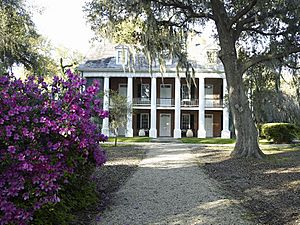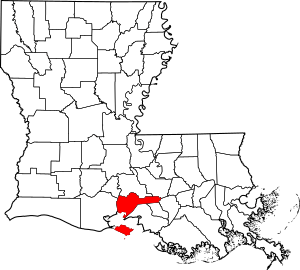Iberia Parish, Louisiana facts for kids
Quick facts for kids
Iberia Parish
|
|
|---|---|

Historic House and Garden Shadows-on-the-Teche
|
|

Location within the U.S. state of Louisiana
|
|
 Louisiana's location within the U.S. |
|
| Country | |
| State | |
| Founded | October 30, 1868 |
| Named for | Iberian Peninsula |
| Seat | New Iberia |
| Largest city | New Iberia |
| Area | |
| • Total | 1,031 sq mi (2,670 km2) |
| • Land | 574 sq mi (1,490 km2) |
| • Water | 456 sq mi (1,180 km2) 44% |
| Population
(2020)
|
|
| • Total | 69,929 |
| • Density | 67.83/sq mi (26.188/km2) |
| Time zone | UTC−6 (Central) |
| • Summer (DST) | UTC−5 (CDT) |
| Congressional district | 3rd |
Iberia Parish is a special kind of county called a parish in the U.S. state of Louisiana. In 2020, about 69,929 people lived there. The main town and government center is New Iberia.
The parish was created in 1868 and got its name from the Iberian Peninsula in Europe. It's part of a larger area in Louisiana called Acadiana, which has many people who speak French. Some of these French-speaking families came from Acadia (now part of Canada) in the 1700s after being forced out by the British. Iberia Parish has also been a major center for growing sugar cane, producing more sugar than any other parish in Louisiana.
Iberia Parish is part of the larger Lafayette city area. It also has the Port of Iberia, which connects to the Gulf Coast by water.
Contents
History of Iberia Parish
Iberia Parish was formed in 1868 from parts of two other parishes: St. Martin Parish and St. Mary Parish. This happened during a time in American history called the Reconstruction era, right after the Civil War. The government at that time wanted to create new parishes where many formerly enslaved African Americans, known as freedmen, lived. This was meant to help them have more political power.
Before and after the Civil War, this area was known for its sugar cane farms, called plantations. These farms relied on a large number of enslaved African Americans to do the work. Sugar cane was a very valuable crop. After the Civil War, relationships between white and Black residents were often difficult.
Later, in the late 1800s, there weren't enough workers for the sugar cane farms. So, many Italian immigrants, especially from Sicily, came to work. They were needed during the harvest season, which lasted from October to January.
In the 1900s, the economy of Iberia Parish changed a lot when oil was discovered. The Port of Iberia grew into an important industrial area. This created new job opportunities for many people, including African Americans. Even with these changes, Iberia Parish still produces the most sugar in Louisiana.
Geography and Nature
Iberia Parish covers a total area of about 1,031 square miles. About 574 square miles of this is land, and 456 square miles (which is 44%) is water. This includes a place called Marsh Island.
Main Roads
 Future Interstate 49
Future Interstate 49 U.S. Highway 90
U.S. Highway 90 Louisiana Highway 14
Louisiana Highway 14 Louisiana Highway 31
Louisiana Highway 31 Louisiana Highway 83
Louisiana Highway 83 Louisiana Highway 85
Louisiana Highway 85 Louisiana Highway 86
Louisiana Highway 86 Louisiana Highway 87
Louisiana Highway 87 Louisiana Highway 182
Louisiana Highway 182
Neighboring Parishes
Iberia Parish shares borders with several other parishes:
- St. Martin Parish (to the north and south)
- Iberville Parish (to the northeast)
- Assumption Parish (to the east)
- St. Mary Parish (to the southeast)
- Vermilion Parish (to the west)
- Lafayette Parish (to the northwest)
Protected Natural Areas
Iberia Parish has special areas set aside to protect nature.
National Protected Area
- Shell Keys National Wildlife Refuge
State Protected Areas
Part of the Attakapas Wildlife Management Area is located in Iberia Parish. This area also extends into St. Mary and St. Martin parishes.
Communities in Iberia Parish
Iberia Parish has several towns and communities.
Cities

- Jeanerette
- New Iberia (This is the main town and where the parish government is located.)
Town
- Delcambre (part of this town is in Iberia Parish)
Village
Census-designated place
Unincorporated communities
These are smaller communities that are not officially part of a city or town.
- Avery Island
- Bob Acres
- Emma
- Olivier
- Rynella
People of Iberia Parish
| Historical population | |||
|---|---|---|---|
| Census | Pop. | %± | |
| 1870 | 9,042 | — | |
| 1880 | 16,676 | 84.4% | |
| 1890 | 20,997 | 25.9% | |
| 1900 | 29,015 | 38.2% | |
| 1910 | 31,262 | 7.7% | |
| 1920 | 26,855 | −14.1% | |
| 1930 | 28,192 | 5.0% | |
| 1940 | 37,183 | 31.9% | |
| 1950 | 40,059 | 7.7% | |
| 1960 | 51,657 | 29.0% | |
| 1970 | 57,397 | 11.1% | |
| 1980 | 63,752 | 11.1% | |
| 1990 | 68,297 | 7.1% | |
| 2000 | 73,266 | 7.3% | |
| 2010 | 73,240 | 0.0% | |
| 2020 | 69,929 | −4.5% | |
| U.S. Decennial Census 1790-1960 1900-1990 1990-2000 2010-2013 |
|||
In 2020, the population of Iberia Parish was 69,929 people. About 25.6% of the people were under 18 years old. Also, about 51.1% of the population was female.
The people living in Iberia Parish come from many different backgrounds. Here's a look at the main groups as of 2020:
| Race | Number | Percentage |
|---|---|---|
| White (not Hispanic) | 38,572 | 55.16% |
| Black or African American (not Hispanic) | 22,984 | 32.87% |
| Native American | 247 | 0.35% |
| Asian | 1,933 | 2.76% |
| Pacific Islander | 3 | 0.0% |
| Other/Mixed | 2,293 | 3.28% |
| Hispanic or Latino | 3,897 | 5.57% |
In 2000, about 11.99% of people in Iberia Parish spoke French or Cajun French at home. A smaller number spoke Lao (1.48%) or Spanish (1.29%).
The average income for a household in the parish was about $48,861 in 2019. About 21.9% of the people in the parish lived at or below the poverty line.
Education in Iberia Parish
The public schools in the parish are managed by the Iberia Parish School System.
There are also several private schools, including Catholic High New Iberia, Acadiana Christian School, and Highland Baptist School.
For higher education, Iberia Parish is served by Fletcher Technical Community College and South Louisiana Community College.
National Guard Units
Two units of the National Guard are based in Iberia Parish. E Company 199th Forward Support Battalion is in Jeanerette, Louisiana. B Company 2-156th is in New Iberia, Louisiana. Both of these units have been sent to Iraq twice, in 2004-2005 and again in 2010, as part of the 256TH IBCT.
See also
 In Spanish: Parroquia de Iberia para niños
In Spanish: Parroquia de Iberia para niños

